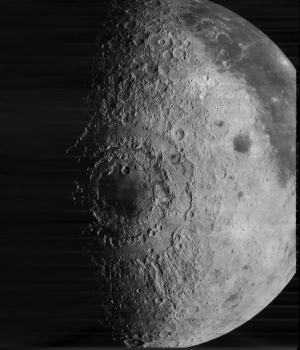Scientists reveal how Orientale crater formed on the Moon billions of years ago
by Colin Smith

The Orientale impact basin resembles a bullseye pattern.
Scientists have simulated the conditions that formed a huge bullseye-shaped crater on the Moon, called Orientale.
The Orientale impact basin is located on the Moon’s south western region, or the left-hand edge as seen from Earth. It is made up of concentric rings that resemble a bullseye pattern. At over 900 kilometres across and with an age of approximately 3.8 billion years, Orientale is one of the largest, the youngest and the best preserved example of what scientists call a multi-ring basin. Multi-ring basins are observed on many of the rocky and icy worlds in our solar system, but scientists have not been able to agree on how they form.

Orientale is approximately 3.8 billion years old.
Now, a team of experts including an Imperial researcher have modelled Orientale's formation by an ancient asteroid strike on the early Moon's surface. The study is providing insights into how these powerful impacts played an important role in the early geological history of the Moon. It is also helping the team to see how multi-ring basins may have formed on other planets.
Smaller impact craters possess a single, well-defined crater rim, which helps scientists to define the crater and work out the size of the asteroid that made the impact. Orientale has many rings and this has made it difficult for researchers to work out which of rings represents the rim (or edge) of the crater, so that they could work out the size of the asteroid that formed it. No craters as large as Orientale, or with as many rings, have been discovered on Earth and laboratory experiments cannot reproduce multi-ring creations, so simulations of the giant impact were key to understanding Orientale’s formation.
Following the impact of the asteroid, the deep crater that was initially created quickly collapsed.
The team in today’s study, published in the journal Science, were able to show with their computer simulation that following the impact of the asteroid, the deep crater that was initially created quickly collapsed. This caused material on the surface and around the outside to flow inward, covering up the exposed rock from the Moon’s interior and generating huge concentric faults outside the crater that cut through the entire crust from the surface to 50 kilometres in depth. The team also worked out the probable size of the asteroid that made the basin, which may have been up to 64 kilometres long.
Dr Gareth Collins, from the Department of Earth Science and Engineering, said: “Next time there’s a full Moon, take a moment to look at it and see if you can spot Orientale on its surface. Imagine the moments after the asteroid impact that created it. It was a world-changing event that in a matter of minutes generated a huge pool of melted rock inside the crater and enormous fault scarps that were several times taller than Grand Canyon.”
“Our model is helping us to see how its distinctive concentric rings were formed, which is really exciting because we now have a much clearer idea of the size of the asteroid that formed this crater and we can now use this information to infer how multi-ring basins on other worlds may have come into being.”
The researchers used data gathered by NASA’s Gravity Recovery and Interior Laboratory (GRAIL) mission. Completed in 2012, the mission consisted of two spacecraft orbiting the Moon. Instruments on board measured changes in gravity caused by different features, such as mountains and craters. These changes in gravity caused the spacecraft to move slightly toward and away from each other as they circled the Moon. An instrument aboard each spacecraft measured the changes in their relative velocity precisely, and scientists translated this information into a high-resolution map of the Moon's gravitational field.
The unprecedented detail in GRAIL’s mapping over the Orientale basin provides new insight into its rings, some of which are shown to extend from the surface to the base of the Moon’s crust, some 50 km below. The authors of the study used this information from the GRAIL mission as a test of their numerical simulations. The close agreement between the position and displacement on the simulated faults to those observed in the GRAIL data confirmed the success of the numerical models as well as the size of the impacting asteroid.
The team believe the method of mapping the Moon via its gravitational field may also help them to uncover other ringed basins buried by subsequent impact events. For instance, the team believe that they may be able to locate ringed basins hidden beneath Lunar Maria – the large, dark areas of solidified lava on the Moon that include the Sea of Tranquillity and the Sea of Serenity.
The research was led by Brown University in the US in collaboration with Imperial.
Article text (excluding photos or graphics) © Imperial College London.
Photos and graphics subject to third party copyright used with permission or © Imperial College London.
Reporter
Colin Smith
Communications and Public Affairs